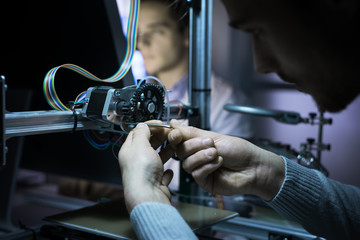The world of 3D printing has revolutionized manufacturing by enabling the creation of complex geometries and customized designs. However, the quality of 3D printed parts directly out of the printer may not always meet the desired standards. That’s where post-processing comes into play.
In this blog post, we will explore everything you need to know about post-processing 3D printed parts, including its definition, importance, common techniques, considerations, advanced techniques, tips for effective post-processing, and more.
Types of 3D Printing Technologies
Before diving into post-processing methods, let’s briefly touch upon some popular 3D printing technologies. These include Fused Deposition Modeling (FDM), Stereolithography (SLA), Selective Laser Sintering (SLS), and more. Each technology has its own characteristics, such as layer thickness, resolution, and material compatibility, which can impact the post-processing requirements for the printed parts.
Common Post-Processing Techniques
Sanding and Smoothing
One of the most common post-processing techniques is sanding and smoothing. This involves using sandpaper and abrasive tools to remove layer lines, imperfections, and rough surfaces from the 3D printed part, resulting in a smoother finish.
Painting and Coating
Painting and coating are popular techniques to enhance the aesthetics and protect the 3D printed parts. Surface imperfections can be concealed with paint, while coatings such as varnish or epoxy can provide a glossy or matte finish, depending on the desired look.
Polishing and Buffing
Polishing and buffing techniques involve using abrasive compounds and polishing tools to achieve a shiny and reflective surface on the 3D printed part. This technique is commonly used for parts that require a high-end finish, such as jewelry or decorative objects.
Dyeing and Staining
Dyeing and staining are effective methods to add color to 3D printed parts. By using dyes or stains that are compatible with the material, vibrant and customized colors can be achieved, enhancing the visual appeal of the parts.
Vapor Smoothing
Vapor smoothing is a technique primarily used for FDM printed parts. By exposing the part to acetone vapor, the outer layers of the printed part can be melted slightly, resulting in a smoother surface finish.
Support Removal
After 3D printing, support structures are often necessary to provide stability during the printing process. However, these supports need to be removed post-printing. Techniques such as cutting, sanding, or dissolving the supports (in the case of water-soluble supports) are employed to achieve a clean and functional final part.
Heat Treatment
Heat treatment involves subjecting the 3D printed part to controlled heating or cooling processes to alter its mechanical properties. This technique is particularly useful for enhancing the strength, durability, or flexibility of certain materials.
Considerations for Post-Processing
While selecting the appropriate post-processing technique, several factors must be considered:
Material Selection
Different materials have varying characteristics and may require specific post-processing techniques to achieve the desired results. For example, some materials may not be suitable for dyeing or require additional steps for proper adhesion of coatings.
Design Considerations
The design of the 3D printed part plays a significant role in determining the complexity and feasibility of post-processing. Intricate designs or parts with hard-to-reach areas might require specialized tools or techniques for effective post-processing.
Safety Precautions
Certain post-processing techniques involve the use of chemicals, heat, or power tools. It is essential to follow safety guidelines, wear appropriate protective equipment, and operate in well-ventilated areas to ensure the safety of yourself and others.
Time and Cost Factors
Post-processing can significantly impact the overall production time and cost. More intricate or time-consuming techniques may increase the production timeline, while additional materials or equipment required for certain post-processing methods may add to the overall cost.
Advanced Post-Processing Techniques
In addition to the common post-processing techniques discussed earlier, there are advanced techniques that can further enhance the quality and functionality of 3D printed parts:
Chemical Finishing
Chemical finishing techniques involve using chemical solutions to treat the surface of the 3D printed part, resulting in improved smoothness, adhesion, or corrosion resistance. Examples include acetone smoothing for ABS or using specific solutions to remove layer lines.
Surface Treatments
Surface treatments, such as shot peening or laser texturing, can be applied to modify the surface properties of 3D printed parts. These treatments can improve hardness, wear resistance, or friction characteristics, making the parts suitable for specific applications.
Metal Plating
Metal plating is a technique where a thin layer of metal, such as nickel or gold, is electroplated onto the surface of the 3D printed
part. This technique enhances the part’s appearance, conductivity, or corrosion resistance, making it suitable for applications where metallic properties are required.
Tips for Effective Post-Processing
To achieve optimal results during post-processing, consider the following tips:
-
Understand the Material: Different materials have unique properties and may require specific post-processing techniques. Familiarize yourself with the material’s characteristics to choose the appropriate method.
-
Plan Ahead: Incorporate post-processing considerations into the design phase. Anticipate areas that may require additional attention during post-processing and make design modifications accordingly.
-
Take Time for Preparation: Properly clean and prepare the 3D printed part before applying any post-processing technique. Removing excess debris or support structures will lead to better results.
-
Test and Iterate: Experiment with different post-processing techniques on sample prints to determine the best approach. This allows you to refine your process and achieve consistent and desirable results.
-
Practice Safety Precautions: Always prioritize safety when working with chemicals, power tools, or heat sources. Wear appropriate protective gear, follow instructions carefully, and work in a well-ventilated area.
-
Document Your Process: Keep track of the post-processing techniques used, including parameters, timings, and materials. This documentation will help you replicate successful outcomes and troubleshoot any issues that may arise.
-
Continuously Learn and Improve: Stay updated on new post-processing techniques, tools, and materials. Attend workshops, join online communities, and seek feedback from experts to enhance your skills and knowledge.



